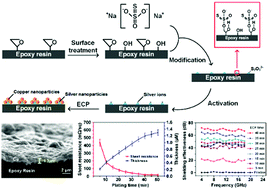Facile preparation of a high-quality copper layer on epoxy resin via electroless plating for applications in electromagnetic interference shielding†
Abstract
A convenient and low-cost approach to fabricate a high-quality copper layer on epoxy resin via electroless plating for applications in electromagnetic interference (EMI) shielding is introduced in this paper. Through the surface modification of thiosulfate (S2O32−), an epoxy resin substrate is able to adsorb silver ions, which could create a catalytic activating layer to catalyze the subsequent electroless copper plating (ECP) of a conductive deposited copper layer at low temperature. The effects of thiosulfate are evaluated based on water contact angle measurement, XPS, FT-IR, SEM, EDS and adhesion tests. The incorporation of thiosulfate effectively modifies the epoxy resin substrate surface, thus promoting adhesion between the epoxy resin and the deposited copper layer. Moreover, after 40 min of ECP, the resulting deposited copper layer presents a low resistivity of 2.24 × 10−6 Ω cm and an excellent electromagnetic interference shielding effectiveness of greater than 60 dB in the frequency range from 4 GHz to 18 GHz. It can be concluded that the developed technology can be used to enable surface metallization of epoxy resin as a highly effective electromagnetic interference shielding material without the use of high temperatures or sophisticated manufacturing equipment.



 Please wait while we load your content...
Please wait while we load your content...